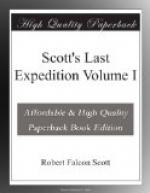Friday, August 25.—The gale continued all night and it blows hard this morning, but the sky is clear, the drift has ceased, and the few whale-back clouds about Erebus carry a promise of improving conditions.
Last night there was an intensely black cloud low on the northern horizon—but for earlier experience of the winter one would have sworn to it as a water sky; but I think the phenomenon is due to the shadow of retreating drift clouds. This morning the sky is clear to the north, so that the sea ice cannot have broken out in the Sound.
During snowy gales it is almost necessary to dress oneself in wind clothes if one ventures outside for the briefest periods—exposed woollen or cloth materials become heavy with powdery crystals in a minute or two, and when brought into the warmth of the hut are soon wringing wet. Where there is no drift it is quicker and easier to slip on an overcoat.
It is not often I have a sentimental attachment for articles of clothing, but I must confess an affection for my veteran uniform overcoat, inspired by its persistent utility. I find that it is twenty-three years of age and can testify to its strenuous existence. It has been spared neither rain, wind, nor salt sea spray, tropic heat nor Arctic cold; it has outlived many sets of buttons, from their glittering gilded youth to green old age, and it supports its four-stripe shoulder straps as gaily as the single lace ring of the early days which proclaimed it the possession of a humble sub-lieutenant. Withal it is still a very long way from the fate of the ‘one-horse shay.’
Taylor gave us his final physiographical lecture last night. It was completely illustrated with slides made from our own negatives, Ponting’s Alpine work, and the choicest illustrations of certain scientific books. The preparation of the slides had involved a good deal of work for Ponting as well as for the lecturer. The lecture dealt with ice erosion, and the pictures made it easy to follow the comparison of our own mountain forms and glacial contours with those that have received so much attention elsewhere. Noticeable differences are the absence of moraine material on the lower surfaces of our glaciers, their relatively insignificant movement, their steep sides, &c.... It is difficult to convey the bearing of the difference or similarity of various features common to the pictures under comparison without their aid. It is sufficient to note that the points to which the lecturer called attention were pretty obvious and that the lecture was exceedingly instructive. The origin of ‘cirques’ or ‘cwms,’ of which we have remarkably fine examples, is still a little mysterious—one notes also the requirement of observation which might throw light on the erosion of previous ages.
After Taylor’s effort Ponting showed a number of very beautiful slides of Alpine scenery—not a few are triumphs of the photographer’s art. As a wind-up Ponting took a flashlight photograph of our hut converted into a lecture hall: a certain amount of faking will be required, but I think this is very allowable under the circumstances.




